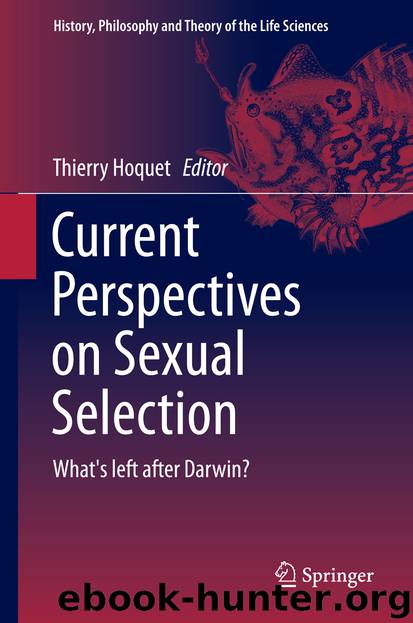Current Perspectives on Sexual Selection by Thierry Hoquet

Author:Thierry Hoquet
Language: eng
Format: epub
Publisher: Springer Netherlands, Dordrecht
7.5 Some Current Controversies
7.5.1 Criticisms of the Darwin-Bateman Paradigm (DBP)
In view of the logical imperative for sexual selection, DBP remains a satisfactory first expectation for species with zero male care and internal fertilisation (i.e. the vast majority of species). As such, it fulfils a similar heuristic purpose as does, say, the Hardy-Weinberg equilibrium for neutral selection on two alleles—i.e. when we find deviations from it, we need to examine why these occur. They are likely to be due to special biological features, which, however interesting, do not negate the validity of DBP as a general rule for the majority of cases (Parker and Birkhead 2013). The current criticisms of DBP relate partly to the fact that deviations from DBP in species with relatively high male parental care are (unsurprisingly) not that uncommon; moreover, there are various other reasons why DBP expectations may not be met (see e.g. Klug et al. 2010).
Attacks on sexual selection and/or DBP have recently arisen from two related but rather different sources. First, Roughgarden et al. (2006) have claimed that the entire concept is flawed and that solutions to male and female sexual adaptation should be sought in terms of ‘social selection’—the principle that mating and associated reproductive activities between the sexes will be cooperative. This critique is based on erroneous claims relating to the quality of the evidence for Darwinian sexual selection and has attracted much criticism (see the multiple responses in Science, 2006, vol. 312, 689–694). Further, while the notion that reproduction can involve cooperation is certainly not novel (e.g. we have long known that sexual cooperation can occur, for instance in animals such as birds with biparental care), this itself involves sexual conflict, which must be fully considered in understanding its evolution and stability. Further, while mutual benefits to each sex may arise from a given reproductive adaptation, these may offer a weak or negligible selective force compared to those arising directly through sexual selection. For example, the guarding phase of male dung flies was originally (Foster 1967) seen as co-operation with the female to ensure more efficient oviposition, but there is strong evidence to suggest that it has arisen through sexual selection for paternity guarding (Parker 1970e).
A second recent critique is the attack on the DBP paradigm, resulting in a ‘gender role’ controversy, i.e. whether DBP—and ultimately the primary sexual difference of anisogamy—does offer an explanation of male and female sex roles and behaviour (see review of Parker and Birkhead 2013). This has also been strongly argued to be misguided (Schärer et al. 2012; Kokko et al. 2013; Parker and Birkhead 2013). However, aspects of this critique are possibly not entirely unrelated to what must be regarded as an excellent and growing development in sexual selection studies, namely an increasing focus on the female perspective, and on female interests in multiple mating, i.e. polyandry (e.g. see the recent theme issue in Phil. Trans. R. Soc. Lond. B 2013, vol. 368 on polyandry).
Download
This site does not store any files on its server. We only index and link to content provided by other sites. Please contact the content providers to delete copyright contents if any and email us, we'll remove relevant links or contents immediately.
Rewire Your Anxious Brain by Catherine M. Pittman(18594)
Talking to Strangers by Malcolm Gladwell(13298)
The Art of Thinking Clearly by Rolf Dobelli(10329)
Mindhunter: Inside the FBI's Elite Serial Crime Unit by John E. Douglas & Mark Olshaker(9266)
Becoming Supernatural by Dr. Joe Dispenza(8171)
Change Your Questions, Change Your Life by Marilee Adams(7690)
Nudge - Improving Decisions about Health, Wealth, and Happiness by Thaler Sunstein(7662)
The Road Less Traveled by M. Scott Peck(7559)
The Lost Art of Listening by Michael P. Nichols(7456)
Mastermind: How to Think Like Sherlock Holmes by Maria Konnikova(7281)
Enlightenment Now: The Case for Reason, Science, Humanism, and Progress by Steven Pinker(7274)
Win Bigly by Scott Adams(7142)
The Way of Zen by Alan W. Watts(6557)
Daring Greatly by Brene Brown(6476)
Big Magic: Creative Living Beyond Fear by Elizabeth Gilbert(5681)
Grit by Angela Duckworth(5557)
Ego Is the Enemy by Ryan Holiday(5351)
Men In Love by Nancy Friday(5201)
The Laws of Human Nature by Robert Greene(5087)
